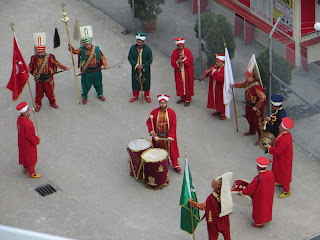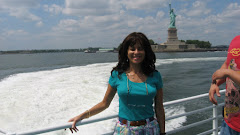Istanbul
I experienced one of the most wonderful visits to one of the most historically significant cities in the world. I chocked as much into a day and a half as is possible and found every minute invigorating. For 2 days, we visited Istanbul, the only city in the world, which straddles both Asia and Europe (split in two by the Bosporus Straights).
A special aspect of the visit was having spectacular views (from our ship) overlooking the Bosporus Straight (and Golden Horn) of key sites including Hagia Sophia, Topkapi Palace, and The Blue Mosque with its 6 minarets. I had breakfast and dinner overlooking this spectacular water view.
Because Istanbul IS a port city, we had easy access from the ship. Within minutes (or a short tram ride) a cruise passenger can enjoy major sites. On our second day, I took the tram from Trophane to Eminonu, to begin my tour. I loved the frenetic energy of the city and felt comfortable touring around on my own, day 2.
Touring around, I felt the glory/power of this once mighty city that served as capital of two of the world’s most powerful empires Byzantine (for 900+ years) and Ottoman Empire (for 600+ years). The Ottoman Empire was an economic, military, and religious powerhouse that ruled a huge chunk of the world spanning, Europe, Asia, and Africa from the 14th till the 20th century.
As we docked in Istanbul in the early morning, we were greeted by a robust and lively folk band of musicians dressed in traditional Turkish decorative uniforms. I was able to zoom in and capture great close ups of them right from my private balcony.
I met my private tour group (of threee couples I met online) in our usual spot, across from the tour desk on deck 3.
We joined our tour guide, Ozlem (ozlemaydin33@gmail.com), who directed us to our bus, whose driver took us directly to the site-filled area: Sultanahmet. Sultanahmet is the Old Town, where the city’s top landmarks are concentrated---including Hagia Sophia, Topkapi Palace, The Blue Mosque, The Basilica Cisterns, Hippodrome Square, and the nearby The Grand Bazaar.
Here are some comments/reflections about my time in Istanbul:
We only used the bus twice: at the beginning and end of our day. Traffic was very congested (a new James Bond movie was being filmed) and the Old Town is best explored on foot.
Sultanahmet Park, situated between the Hagia Sophia and Blue Mosque, provides a great photo opp for both grand structures.
The Hagia Sophia is one of the most impressive buildings in the world and the crowning achievement of the Byzantine Empire. Constructed by Emperor Justinian during the 6thcentury, it remained the largest basilica in the world for centuries and the remains the worlds 4th largest ever built. It served as the Patriarchal church of Constantinople nearly a millennium until the Ottomans captured Constantinople in 1453. Although the Ottoman Turks were Muslim, they were so captivated by the cathedral’s grand scale and beauty, they chose to preserve rather than destroy it. Instead, they converted it to a mosque adding minarets, covering Christian mosaics and frescoes with Islamic artwork, and adding an imam’s pulpit and mihrab facing Mecca, among its many modifications. After the secular Republic of Turkey was established, the Hagia Sophia was converted to a museum in 1936. As a result, many (well-preserved), original Christian frescoes, which had been plastered over with whitewash, were uncovered and are now on display. The eight iconic 24-ft wide leather medallions with Arabic calligraphy continue to dominate the apse, center and arches above the imperial gate.
The Blue Mosque was the first mosque outside Mecca to have six minarets, likely a display of the Sultan’s wealth. In order to avoid upstaging the central mosque in Mecca, which had six minarets, Sultan Ahmet I financed construction of a seventh minaret there. Construction of this mosque marks the beginning of the Ottoman Empire’s decline because it exhausted the treasury that was never restored due to a succession of wars and incompetent rulers.
I saw the famous Medusa heads in the underground Basilica Cistern (the vast, dimly-lit, former underground water reservoir, built in the 6th century).
The Waterway intersection of The Golden Horn, Bosporus Straight, and Sea of Marmara is one of the busiest in the world. There was a continuous flow of ferry, barge, commercial ship, cruise ship etc. traffic. With its spectacular views, it’s no wonder that Sultan Mehmet The Conqueror chose to this prime location on which to build his Topkapi palace.
We had a delectable and inexpensive lunch at Buhara 93 (Nakilbend Caddesi 15-near the Hippodrome). I ordered the chicken Kebab with rice and salad for 8 or 9TL. They have open wood-fired ovens where you can watch men baking the famous lavas (flat bread). (It really is mentioned in Rick Steve’s guide, as their sign says)
 |
| Ozlem (our tour guide) and Karla |
I found the vendors at the Grand Bazaar (and Spice market) to be in-your-face aggressive. The whole experience can be a bit overwhelming at first, but, the loud, colorful, crowded covered malls grow on you after a while. The opening line in Turkish bazaars is always, “Where are you from”? I am always delighted when vendors cannot guess where I am from since they are generally skilled at discerning the heritage of tourists. My favorite line was, “How can I hassle you today?”. My favorite sign was “Real Fake Watches Sold Here”. There are more than 4000 stalls in a maze of streets in the grand bazaar selling carpets, ceramics, jewelry (gold, silver, precious/semi-precious stone, byzantine replicas), textiles, copperware, mosaics, spices, Turkish handicrafts, clothing, water pipes, Turkish delights, Evil eye merchandise, and of course, souvenirs, and more.
On my next visit, I will go to the bustling Taksim Square and Istikal Cadessi (Street) via the tram and funicular.




















.jpg)
.jpg)




No comments:
Post a Comment